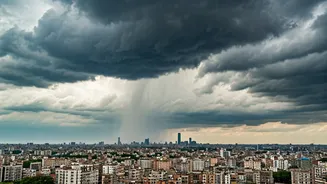AI's Predictive Power
AI has become a game-changer in storm surge prediction. Previously, forecasting storm surges relied on complex models and extensive data analysis, a process
that was both time-consuming and prone to inaccuracies. Now, AI algorithms can analyze massive datasets, including historical weather patterns, ocean conditions, and coastal topography, much faster than traditional methods. This enables forecasters to identify patterns and predict storm surge behavior with enhanced accuracy. AI's ability to process vast amounts of data allows it to identify subtle correlations and contributing factors that might be missed by conventional models. AI models are continuously refined and updated with new data, which means their predictive capabilities improve over time, providing increasingly reliable forecasts. The integration of AI into storm surge forecasting is not just about speed; it's about making more informed decisions, offering better protection to communities in the face of increasingly severe weather.
Boosting Accuracy Quickly
One of the most notable advantages of AI in storm surge prediction is the considerable improvement in forecast accuracy. AI models are adept at understanding the complex interactions between various factors that contribute to storm surges, such as wind speed, storm intensity, and coastal geometry. This comprehensive understanding allows them to generate precise forecasts that account for nuances often missed by traditional methods. As a result, the alerts are better tailored to specific locations and provide a more accurate assessment of the potential risks. Early and more precise warnings allow local authorities and residents to take more effective preparatory measures, reducing the potential impact of storm surges. This might include implementing evacuation orders, reinforcing infrastructure, and securing essential resources. AI's ability to swiftly process data and deliver accurate predictions translates directly into greater community safety and preparedness when confronting hazardous weather conditions.
Speedy Prediction Process
AI accelerates the entire forecasting process, producing storm surge predictions far quicker than traditional methods. The conventional models often require considerable time and processing power, whereas AI algorithms can quickly analyze vast datasets, including real-time weather data and historical information. This acceleration translates into more prompt and timely warnings, granting communities precious extra time to prepare and respond to the threats posed by an impending storm surge. The improved speed of AI-driven forecasts is particularly critical during rapidly evolving weather events, where conditions can change swiftly. AI's ability to provide quick updates and refine predictions as new data becomes available ensures that forecasts stay current and relevant, supporting continuous decision-making. The combination of swiftness and accuracy empowers emergency managers and individuals alike to make well-informed decisions regarding safety measures and resource allocation, decreasing potential damage and harm.
Community Safety Enhanced
The integration of AI into storm surge forecasting has significant implications for community safety. Accurate and prompt forecasts allow for the implementation of appropriate protective measures, such as timely evacuations, reinforcement of infrastructure, and resource deployment. This proactive approach significantly diminishes the potential risks associated with storm surges. Early warnings empower residents and local authorities to take actions, from securing personal property to establishing emergency shelters, which can help reduce the direct impacts of these events. AI also contributes to more efficient resource allocation during emergencies. It allows for the focused deployment of aid and resources to the areas most in need, thereby improving response efforts. Ultimately, AI-driven storm surge forecasting contributes to a safer, more resilient community that is better prepared to handle the challenges presented by severe weather conditions.












